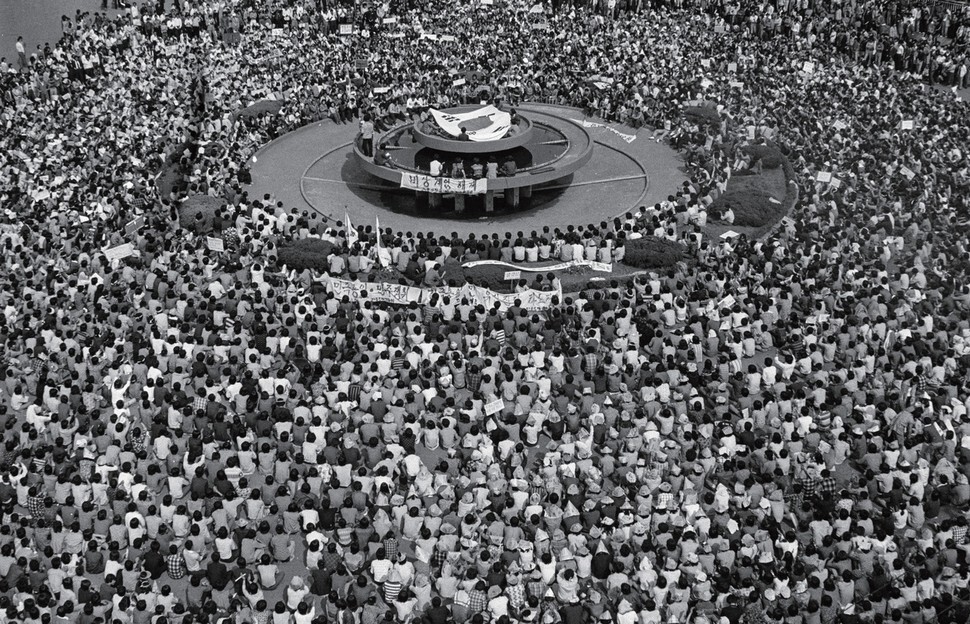hankyoreh
Links to other country sites 다른 나라 사이트 링크
Documents reveal Chun Doo-hwan regime hid truth about Gwangju to US

On May 15, formerly classified documents detailing conversations between the US ambassador and the leaders of South Korea’s military junta in 1980 were made public. In the conversations, US Ambassador William H. Gleysteen and the leaders of South Korea’s military junta — including Chun Doo-hwan and Lee Hui-sung — discussed Korea’s military coup on Dec. 12, 1979, and measures taken to expand martial law on May 17, 1980.
Most of the documents are cables that were exchanged between the US Embassy in Seoul and the US government back in Washington around the time of the Gwangju Democratization Movement, which began on May 18, 1980. They are part of a group of 43 declassified diplomatic documents that the US State Department recently sent South Korea’s Ministry of Foreign Affairs.
The released documents make clear what Ambassador Gleysteen thought of Chun Doo-hwan, then Korea’s Defense Security commander and ringleader of the coup. Referring to Chun’s claim that the Dec. 12 incident had not been a coup or a revolution but rather an attempt to investigate the assassination of President Park Chung-hee, Gleysteen said that Chun had made a long-winded and undoubtedly self-serving explanation.
The documents also reveal that Chun had asked the US for help in preventing a counterattack by forces loyal to Army Chief of Staff Gen. Jeong Seung-hwa. “He warned that while there was a surface calm, he feared large numbers of Jeong supporters in the army might seek to redress the situation over the next few weeks. Obviously Chun and his colleagues would like to enlist our help in containing military counter action [by their opponents],” Gleysteen wrote.
In a cable sent to Washington on May 18, 1980, Gleysteen reported that martial law commander Lee Hee-sung said he “feared the ROK would be communized in a manner similar to Vietnam” while arguing that the expansion of martial law on May 17 had been unavoidable. The military junta attempted to justify its seizure of power by misrepresenting the student movement as being anti-American communists.
Following a meeting with Blue House Chief of Staff Choe Gwang-su shortly after martial law was expanded, Gleysteen wrote that Choe was doubtful about whether President Choi Kyu-hah had much of a say in lifting martial law. The chief of staff also informed Gleysteen that the military junta was sharply criticizing the government for its use of conciliatory tactics with the university protesters. Some of the declassified documents were exchanged between the US Embassy and Washington before the end of Kim Dae-jung’s trial for sedition and conspiracy in December 1980 in order to seek clemency for Kim.
This batch of documents had been previously released by the US State Department to the press and civic groups in 1996, under the Freedom of Information Act. While significant portions of those documents were redacted at the time, they have now been released in their entirety.
“We asked [the American government] for all documents pertaining to the year after the Dec. 12 coup in order to assess the context of the six months before and after the Gwangju Democratization Movement. We plan to work with the fact-finding and other organizations to ask the US to release more documents,” an official from South Korea’s Ministry of Foreign Affairs told reporters.
However, these documents do not contain any proof that Chun Doo-hwan was ultimately responsible for the violent suppression of the Gwangju movement. Groups seeking to learn the truth about the events in Gwangju that May think that information related to the bloody crackdown on the uprising, including the order to open fire on the protesters, was likely reported through military channels, including those at ROK-US Combined Forces Command.
By Noh Ji-won, staff reporter
Please direct comments or questions to [english@hani.co.kr]

Editorial・opinion
![[Editorial] Japan’s rewriting of history with Korea has gone too far [Editorial] Japan’s rewriting of history with Korea has gone too far](https://flexible.img.hani.co.kr/flexible/normal/500/300/imgdb/original/2024/0422/1717137715201877.jpg) [Editorial] Japan’s rewriting of history with Korea has gone too far
[Editorial] Japan’s rewriting of history with Korea has gone too far![[Column] The president’s questionable capacity for dialogue [Column] The president’s questionable capacity for dialogue](https://flexible.img.hani.co.kr/flexible/normal/500/300/imgdb/original/2024/0422/1517137717613239.jpg) [Column] The president’s questionable capacity for dialogue
[Column] The president’s questionable capacity for dialogue- [Column] Are chaebol firms just pizza pies for families to divvy up as they please?
- [Column] Has Korea, too, crossed the Rubicon on China?
- [Correspondent’s column] In Japan’s alliance with US, echoes of its past alliances with UK
- [Editorial] Does Yoon think the Korean public is wrong?
- [Editorial] As it bolsters its alliance with US, Japan must be accountable for past
- [Guest essay] Amending the Constitution is Yoon’s key to leaving office in public’s good graces
- [Editorial] 10 years on, lessons of Sewol tragedy must never be forgotten
- [Column] A death blow to Korea’s prosecutor politics
Most viewed articles
- 1Korean government’s compromise plan for medical reform swiftly rejected by doctors
- 2[Column] The president’s questionable capacity for dialogue
- 3[Editorial] Japan’s rewriting of history with Korea has gone too far
- 4Samsung barricades office as unionized workers strike for better conditions
- 5[Reporter’s notebook] Did playing favorites with US, Japan fail to earn Yoon a G7 summit invite?
- 6[Column] The clock is ticking for Korea’s first lady
- 7Korea protests Japanese PM’s offering at war-linked Yasukuni Shrine
- 8All eyes on Xiaomi after it pulls off EV that Apple couldn’t
- 9[Column] Are chaebol firms just pizza pies for families to divvy up as they please?
- 10What Israel’s ‘warning shot’ response to Iran means for Middle East tensions